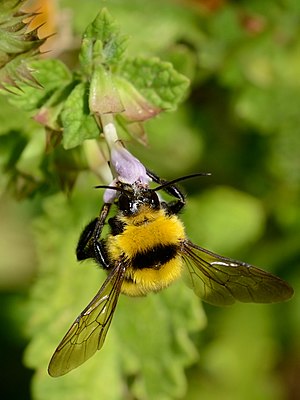Alumina bumblebee
| Alumina bumblebee | ||||||||||||
|---|---|---|---|---|---|---|---|---|---|---|---|---|

Alumina bumblebee ( Bombus argillaceus ) |
||||||||||||
| Systematics | ||||||||||||
|
||||||||||||
| Scientific name | ||||||||||||
| Bombus argillaceus | ||||||||||||
| ( Scopoli , 1763) |
The clay bumblebee ( Bombus argillaceus ) is a species from the genus of the bumblebees ( Bombus ). Eberhard von Hagen gave her her German name .
Habitat and Distribution
In Central Europe ( Austria , Switzerland , Southern Germany ), the clay bumblebee is only common on so-called heat islands, i.e. H. in places with many hours of sunshine. There she inhabits both the plains and mountains up to 1300 m altitude. Large underground mouse nests (especially the water vole ) serve as nesting sites , in which the queen founds a colony from the end of April. The colony size varies between 100 and 500 individuals. The first workers will fly from mid-May, young queens and drones from mid-August. At the beginning of October the people finally die. The Tonerdhummel belongs to the pocket makers .
Mark
The alumina bumblebee has two bright yellow cross bands on its thorax . The queen's abdomen is completely black, whereas the 1st tergite of workers and drones is yellow, the 5th and 6th white. This can lead to confusion with the garden bumblebee or other earth bumblebees .
Toner bumblebee queens reach a size of 24 to 28 mm, workers 8–19 mm and drones 12–17 mm. They all have a very long head and long trunk. The wings are darker than other bumblebees.
Due to its size, the clay bumblebee is probably the largest bumblebee in Germany, as the queens of the dark bumblebee and field bumblebee only have a size of max. 24 mm reached.
food
Like all bumblebees, the alumina bumblebee feeds on nectar and its larvae on pollen. Her main ornamental plants include: clover , black nettle , comfrey and toadflax .
Danger
The clay bumblebee is listed in the Red List of Endangered Species of the Federal Agency for Nature Conservation (BfN) under Category 2 and is therefore considered to be critically endangered .
literature
- Eberhard von Hagen: Bumblebees: determine, settle, multiply, protect . Natur-Verlag, Augsburg 1990, ISBN 3-89440-546-5
Web links
- Alumina bumblebees at wildbienen.de
- Bombus argillaceus at Fauna Europaea. Retrieved June 8, 2014